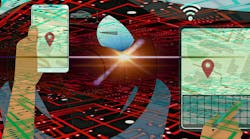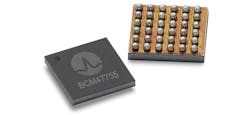Broadcom Boosts Vehicle Navigation with New Dual-Frequency Receiver
Download this article as a .PDF
While navigation is obviously something that many drivers depend on, one company decided to create a solution to enhance the navigation experience. That solution is Broadcom Limited’s new BCM47755, which is a single-chip, dual-frequency global-navigation satellite-system (GNSS) receiver (Fig. 1). According to Broadcom, the BCM47755 is the first mass-market, dual- frequency GNSS receiver device. It is intended for smartphones, tablets, and wearables. The BCM47755 could also find its way into other Internet of Things (IoT) devices.
Traditional GNSS receivers have only used the L1 signal. However, the BCM47755 uses both L1 and L5 signals. As Manuel del Castillo, associate director, GNSS product marketing at Broadcom, explains, “With the BCM47755, both L1 and L5 signals from the same satellite are used. This is needed because L1 is a more basic signal, while L5 is more advanced. With L1, positioning can be computed with fewer resources and in less time. The approach is to start with L1 for basic acquisition and then switch to L5. Once we have L5, we don’t need L1. Thus, we believe that the BCM47755 allows for the best of both worlds.”
Simultaneously receiving L1 and L5 signals allows for a 30-cm accuracy. Multipath correction, detection of reflected signals, and ionospheric error correction are all benefits that are associated with the BCM47755. Furthermore, the 30-cm accuracy essentially means that “lane-level” accuracy is realized on a highway. Figure 2 shows an actual driving track when utilizing the BCM47755.
Consumers are likely to benefit from lane-level accuracy in several ways. For one, a turn-by-turn navigator could provide much more precise navigation instructions and estimated time of arrival (ETA). Using the BCM47755 could also allow much more accurate information with regard to taxi, car-sharing, and ride-hailing applications. This capability is especially significant with the emergence of services like Uber and Lyft.
Based on 28-nm process technology, the BCM47755 incorporates a dual-frequency, low-power GNSS radio along with a dual-core ARM CM4-CM0 sensor hub. Power consumption is reduced by approximately 50% in comparison with the previous-generation chip. Specifically, current consumption can be less than 5 mA during GNSS tracking.
“In 2017, there are 30 satellites orbiting the earth with dual-band capability,” notes del Castillo. “This is the right time to implement L1 and L5 capability in a smartphone.” Broadcom has been sampling the BCM47755 since January and expects it to be used in consumer devices in 2018.



